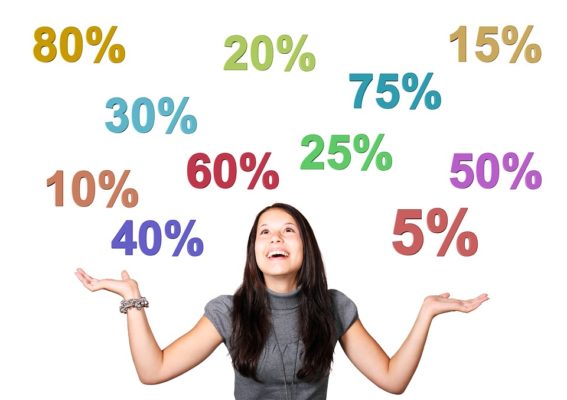New Insights on How We Shop
We’re making our lists and checking…the price tags twice! Are we getting the best deals? Do we buy smarter when we visit the store or peruse online? Derick Davis, Assistant Professor of Commerce in the McIntire School of Commerce at the University of Virginia, details the psychology behind how we approach holiday shopping.
Ho Ho Hoos! Let us know how YOU shop. Do you set a discount minimum? Do you spend more for those you love and less for those you like? Are you a better shopper when you are standing or sitting? Please comment below!
This year’s holiday season is well underway, and many of us still have items on our shopping list. I thought sharing recent insights from my consumer behavior research could be useful as we continue to visit stores and websites, and make purchases.
 A large proportion of purchases made during the holidays involve those we love, either directly through gifts or via incidental purchases such as decorations, party favors, or boxes and wrapping paper. Perhaps it is unsurprising to hear that when shopping for gifts—especially important or symbolic gifts—consumers often resist searching for lower prices. It may, however, be surprising to learn that this resistance to “putting a price on love” extends to incidental purchases. For instance, consumers are less willing to visit another store or website to find a better price on everyday items such as cardboard boxes when they associate the purchase with a loved one (McGraw, Davis, Scott and Tetlock, 2016). Although overpaying a few cents or dollars on one item may not seem consequential, in aggregate this behavior may lead to overspending.
A large proportion of purchases made during the holidays involve those we love, either directly through gifts or via incidental purchases such as decorations, party favors, or boxes and wrapping paper. Perhaps it is unsurprising to hear that when shopping for gifts—especially important or symbolic gifts—consumers often resist searching for lower prices. It may, however, be surprising to learn that this resistance to “putting a price on love” extends to incidental purchases. For instance, consumers are less willing to visit another store or website to find a better price on everyday items such as cardboard boxes when they associate the purchase with a loved one (McGraw, Davis, Scott and Tetlock, 2016). Although overpaying a few cents or dollars on one item may not seem consequential, in aggregate this behavior may lead to overspending.
 When we do search for lower prices, the numbers we encounter—and the order in which we encounter them—can influence our perceptions. For instance, retailers often use “stacked” discounts (e.g., take 12% off the retail price, then an additional 18% off the discounted price), and how stacked discounts are presented influences perceptions of the overall deal. Some shoppers add the two discounts (erroneously) and believe the overall discount is 30% (the effective discount is 27.14% via multiplication). Not all consumers add stacked discounts, so how do consumers who know not to add, but also do not perform the actual calculations, perceive the overall discount? When presented at the same time, 18% then 12% off seems like a better deal than 12% then 18% off because consumers overweigh the first percentage when forming their judgment (the effective discount is still 27.14%; it is invariant to ordering).
When we do search for lower prices, the numbers we encounter—and the order in which we encounter them—can influence our perceptions. For instance, retailers often use “stacked” discounts (e.g., take 12% off the retail price, then an additional 18% off the discounted price), and how stacked discounts are presented influences perceptions of the overall deal. Some shoppers add the two discounts (erroneously) and believe the overall discount is 30% (the effective discount is 27.14% via multiplication). Not all consumers add stacked discounts, so how do consumers who know not to add, but also do not perform the actual calculations, perceive the overall discount? When presented at the same time, 18% then 12% off seems like a better deal than 12% then 18% off because consumers overweigh the first percentage when forming their judgment (the effective discount is still 27.14%; it is invariant to ordering).
By contrast, when consumers encounter stacked discounts sequentially (different points in time) they overweigh the second percentage and view the 12% then 18% ordering more positively (Davis and Bagchi, forthcoming). An interesting consequence is that, on average, consumers who simply add are swayed less by stacked discounts than those who know not to add, but do not perform the calculations. Relatedly, when shopping for bulk packaged items, if consumers view the item quantity (e.g., 100 ornaments) before the price, they overweigh quantity relative to price and thus view the overall deal more favorably. The reverse is true when the price is encountered first (Bagchi and Davis, 2012).
 Changes in the way we shop can have unforeseen consequences. Consumers have shifted many purchases from physical to online stores, which led my colleague at Darden, Luca Cian, and I to investigate a resultant change in consumers themselves—body position. Typically, we are standing during the majority of purchase decisions made in brick and mortar stores, whereas we are likely seated at a desk or on the couch when shopping online. Does body position affect our decisions? We find consumers are more likely to stick to a goal (e.g., getting a good price) when they are standing vs. sitting—provided they are not tired (being tired eliminates the effect; Davis and Cian working paper). We gave smartphone users a goal to choose headphones that were a good price from a set of four options. They viewed and chose from the options while sitting or standing. Those who were standing and were not tired were more likely to choose the less expensive options, thus better adhering to their goal.
Changes in the way we shop can have unforeseen consequences. Consumers have shifted many purchases from physical to online stores, which led my colleague at Darden, Luca Cian, and I to investigate a resultant change in consumers themselves—body position. Typically, we are standing during the majority of purchase decisions made in brick and mortar stores, whereas we are likely seated at a desk or on the couch when shopping online. Does body position affect our decisions? We find consumers are more likely to stick to a goal (e.g., getting a good price) when they are standing vs. sitting—provided they are not tired (being tired eliminates the effect; Davis and Cian working paper). We gave smartphone users a goal to choose headphones that were a good price from a set of four options. They viewed and chose from the options while sitting or standing. Those who were standing and were not tired were more likely to choose the less expensive options, thus better adhering to their goal.
In summary, our purchase decisions this holiday season can be influenced by many factors. I suggest “putting a price on love” when you can, especially for the little things; keeping your calculator handy; and making decisions when you are not tired, preferably while standing!
REFERENCES
Bagchi, Rajesh, and Derick F. Davis (2012), “$29 for 70 Items or 70 Items for $29: How Presentation Order Affects Package Perceptions,” Journal of Consumer Research, 39 (June), 62-73.
Davis, Derick F. (working paper), “Distribution Distance Effect”
Davis, Derick F. and Luca Cian (working paper), “Standing Helps Energetic Individuals Exert Self-Control.”
Davis, Derick F. and Rajesh Bagchi (forthcoming), “How Evaluations of Multiple Percentage Price Changes are Influenced by Presentation Mode and Percentage Ordering: The Role of Anchoring and Surprise,” Journal of Marketing Research
McGraw, A. Peter, Derick F. Davis, Sydney Scott, and Phillip E. Tetlock (2016), “The Price of Not Putting a Price on Love,” Judgment and Decision Making, 11 (January), 40-47.
- Having a Drink With Your Donkey: The Absurd in Antiquity
- What Happens to UVA’s Recycling? A Behind the Scenes Look at Recycling, Composting, and Reuse on Grounds
- Finding Your Center: Using Values Clarification to Navigate Stress
- UVA Club of Atlanta: Virtual Pilates Class
- UVA Club of Fairfield/Westchester: Cavs Care - Food Pantry Donation Drive
- UVA Club of the Triangle: Hoo-liday Party

